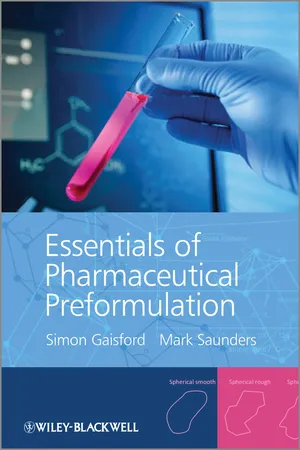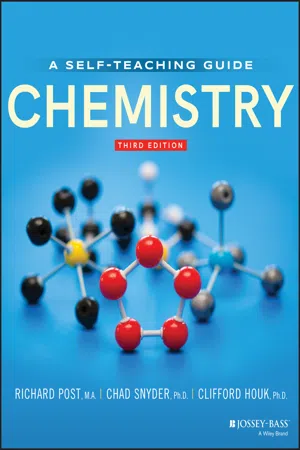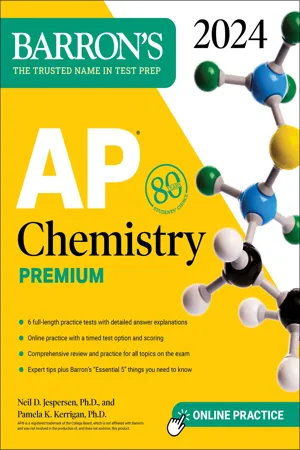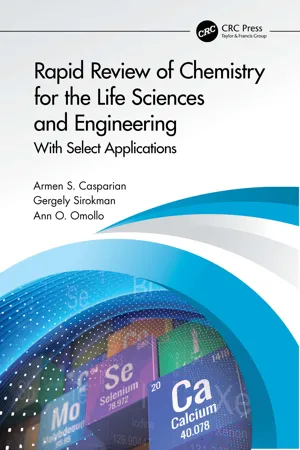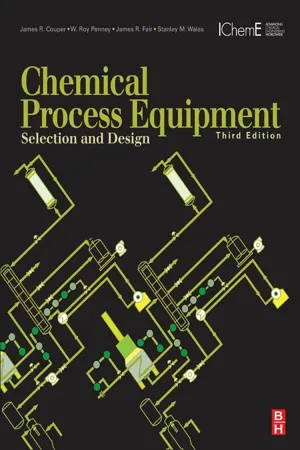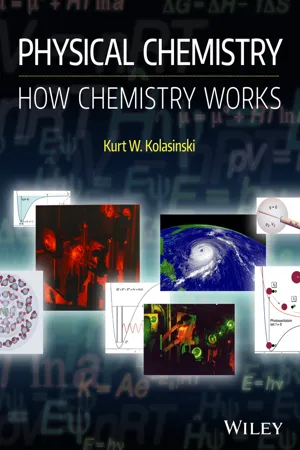Chemistry
Solubility Equilibria
Solubility equilibria refer to the dynamic balance between the dissolution and precipitation of a solute in a solvent. This equilibrium is governed by the solubility product constant, which is a measure of the solute's tendency to dissolve. Understanding solubility equilibria is crucial for predicting the formation of precipitates and determining the solubility of various compounds in solution.
Written by Perlego with AI-assistance
Related key terms
Related key terms
1 of 4
Related key terms
1 of 3
9 Key excerpts on "Solubility Equilibria"
- eBook - ePub
- Detlev Möller(Author)
- 2015(Publication Date)
- De Gruyter(Publisher)
solvation , i.e. the dissolved molecule becomes surrounded by solvent molecules:The index (aq) also often includes that the species is hydrated (solvated by H2 O). Additionally, the solubility can be increased by complexation (see Chapter 3.2.2.7). Solubility quantifies the dynamic equilibrium state (Equation (3.64) ) achieved when the rate of dissolution equals the rate of precipitation . The solubility depends on temperature. It can be derived in a similar equation as for evaporation (Equation (3.50) ) where solvation enthalpy for indefinite dilution:If the saturation concentration is exceeded (for example by changing T and pH), the solute precipitates and forms a solid precipitate (or sediment ). Salts dissociate (the charge is here not important for describing the solubility and therefore not regarded, see Equation (3.44) ):The equilibrium is described by (see Chapter 3.2.2.1):The term [AB]s denotes the concentration of AB in the pure substance AB and is therefore constant (e.g. dimension in mol per litre or kilogram). We define a solubility product constant K sp and can write:K sp = [A]α [B]β = K diss [Aα Bβ ] . (3.68)The T dependency in the case of electrolytes is now given by (see Equation (3.56) ):Note that in Equation (3.67) and Equation (3.68) instead of concentration c , activity a (see Chapter 3.1.2.4) must be used more exactly. However, in the case of diluted solutions and difficultly soluble substances (e.g. SiO2 , CaCO3 - eBook - ePub
- Simon Gaisford, Mark Saunders(Authors)
- 2012(Publication Date)
- Wiley-Blackwell(Publisher)
4.5 ) the reason for the term equilibrium solubility noted earlier.It appears from Equation (4.2 ) that the crystal lattice energy might affect solubility. It also seems from Equation (4.1 ) that there should be an effect of temperature on solubility, since the position of equilibrium will change. Both of these effects can be explored further through the concept of ideal solubility .Summary box 4.14.2.1 Ideal solubility- Solubility is the maximum concentration of a given solute that can be attained in a given solvent.
- Solids transition to solution by dissolution.
- Thermodynamic solubility is a position of equilibrium.
- Dissolution governs the rate at which solubility is achieved.
- As a general rule, solubility below 1 mg mL−1 is likely to hinder development while solubility above 10 mg mL−1 is acceptable.
In the special case where the enthalpy of any solute–solvent interaction is equal to the enthalpy of any solvent–solvent interaction then solvation of the solute may occur with no change in enthalpy (i.e. Δmix H = 0) and dissolution is said to be ideal . Formation of an ideal solution also occurs with the following change in entropy ( ):(4.6)where R is the universal gas constant (8.314 J K−1 mol−1 ). Ideal dissolution (although unlikely, because the solute and solvent molecules would need to possess identical properties, such as size, shape and chemical nature) leads to ideal solubility and is an interesting theoretical position because it can be described in thermodynamic terms, which allows calculation of the dependence of solubility on temperature.From Equation (4.2 ) if Δmix H = 0 then Δf H is equal to Δsol H (note that since Δf H must be positive, i.e. endothermic, Δsol H must also be positive for ideal dissolution). For a process to occur spontaneously the Gibbs free energy (ΔG ) must be negative. The familiar thermodynamic relationship for dissolution is(4.7)where T is absolute temperature. Δsol G is most likely to be negative when Δsol H is negative but, as noted above, Δsol H is frequently positive for dissolution and must be so when dissolution is ideal. This means that for dissolution to occur spontaneously the driving force can only be a significant increase in entropy. Since the mole fractions of both solvent and solute must be less than 1, the logarithmic terms in Equation (4.6 - eBook - ePub
Chemistry
Concepts and Problems, A Self-Teaching Guide
- Richard Post, Chad Snyder, Clifford C. Houk(Authors)
- 2020(Publication Date)
- Jossey-Bass(Publisher)
12 Chemical EquilibriumYou have just learned several properties of solutions (mixtures of solids, liquids, and gases). We have discussed reactions that go to completion (reactants totally consumed, leaving only new products) in Chapter 5 and electrolytes that dissociate completely in water in Chapter 11 . Both of these concepts imply a one-way reaction, continuous movement toward the product side. However, in Chapter 10 we discussed a dynamic equilibrium where the rate of evaporation equals the rate of condensation, that is, the reactions are “reversible.”Many chemical reactions are reversible. The products formed react to give back the original reactants, even as the reactants are forming more products. After some time, both the forward and reverse reactions will be going on at the same rate. When this occurs, the reaction is said to have reached equilibrium. There is no further change in the amount of any reactant or product, though both reactions still go on (forever). Since there are many such reactions that appear to go only partway to completion, their study is of major importance to the chemist.We will discuss several types of equilibrium in this chapter, along with their associated problems and concepts. You will use the concept of molarity you just learned in Chapter 11 - No longer available |Learn more
- Neil D. Jespersen, Pamela Kerrigan(Authors)
- 2023(Publication Date)
- Barrons Educational Services(Publisher)
PART 4Physical Chemistry
Passage contains an image
9
Chemical Equilibrium
Learning Objectives
In this chapter, you will learn:➔Chemical equilibrium ➔Dynamic equilibrium ➔Equilibrium expression ➔Law of mass action ➔Equilibrium constant➔Kc , kp , ka , kb , ks p , kf➔Manipulating the equilibrium expression ➔Thermodynamically favorable reactions ➔Extent of reaction➔Reaction quotient, Q➔Equilibrium calculations➔Determination of K➔Solubility product ➔Le Châtelier’s principleThe concept of a dynamic equilibrium is central to many aspects of chemistry. In a dynamic equilibrium, chemicals are reacting rapidly at the molecular scale, while their concentrations remain constant on the macroscopic scale.Figure 9.1 shows that a chemical reaction has two well-defined regions in time, and these regions are studied and measured in very different ways. When compounds are first mixed in a chemical reaction, they interact to form other compounds. During the reaction process, the concentrations of the reactants decrease and the concentrations of the products increase. While the concentrations are changing, the reaction is studied using the principles of chemical kinetics, which are reviewed in Chapter 10 . At some point in time, the concentrations of the reactants and products stop changing. Although reactions do not stop at the molecular level, at the macroscopic level the concentrations of compounds in a dynamic equilibrium remain constant. At this point, the compounds are in a dynamic chemical equilibrium with each other, and they are studied and described using the concepts of chemical equilibrium.Figure 9.1 - No longer available |Learn more
- Steven Boone, Drew H. Wolfe(Authors)
- 2011(Publication Date)
- Collins Reference(Publisher)
CHAPTER 15Introduction to Chemical Equilibria
Chemical equilibrium systems are more resistant to change than those that are not in equilibrium. When an equilibrium system is disturbed, it responds in order to reestablish a state of equilibrium.15.1 THE EQUILIBRIUM STATEChemical reactions proceed spontaneously until they reach a state of dynamic equilibrium. At equilibrium, the rate of the forward reaction equals the rate of the reverse reaction. At this point, the reactant and product concentrations remain constant.Forward and Reverse ReactionsArrows that point in opposite directions, , show that an equilibrium has established. For example, the following equation is written for the equilibrium of H2 and CO2 with CO and H2 O.H2 (g) + CO2 (g) CO(g) + H2 O(g)The reaction that goes from left to right is the forward reaction, and the reaction that goes from right to left is the reverse reaction. Establishing Equilibrium Consider the following model reaction as it establishes equilibrium.H2 (g) + CO2 (g) → CO(g) + H2 O(g)When H2 and CO2 mix at constant temperature in a reaction vessel, they combine and begin to form the products, CO and H2 O. Hence, the concentrations of H2 and CO2 decrease, and the concentrations of CO and H2 O increase. As the reactant concentrations decrease, the rate of the forward reaction decreases and the rate of the reverse reaction increases. At some point, the rate of the forward reaction equals the rate of the reverse reaction and a chemical equilibrium establishes. After this time, the concentrations of the reactants and products do not change.The Equilibrium Constant ExpressionAn important quantitative relationship exists between the concentrations of the reactants and products. This relationship was identified by Cato Maxmilian Guldberg and Peter Waage in 1864 when they proposed the Law of Mass Action that expresses the equilibrium concentrations of the reactants and products in terms of an equilibrium constant expression (equilibrium expression - eBook - ePub
Rapid Review of Chemistry for the Life Sciences and Engineering
With Select Applications
- Armen S. Casparian, Gergely Sirokman, Ann Omollo(Authors)
- 2021(Publication Date)
- CRC Press(Publisher)
4 Chemical EquilibriumDOI: 10.1201/9781003092759-44.1 Basic Concept
Reaction equations describe substances, called reactants, which when put together react and produce other different substances, called products. It may appear as if only products remain after the reaction is finished. In reality, many reactions do not go to completion, even if the reactants are present in stoichiometric ratios or amounts. Rather, they reach a condition known as equilibrium, denoted by double, reversible arrows in the reaction equation. Equilibrium means that there is a balance between the reactant side and the product side, or simply between the reactants and the products, and that the reaction is reversible. The chemistry of many air pollutants falls and many bodily functions under the heading of equilibrium reactions. The equilibrium condition is dynamic, not static, allowing microscopic changes in reactant and product concentrations to take place, such that no net change in reactant or product concentrations occurs, provided that no external stresses are applied. At any given time, all species in the reaction equation—reactants and products—are present at equilibrium in varying amounts. The relationship among these varying amounts can be described by a mathematical formula known as the equilibrium constant expression or simply the equilibrium expression. The equilibrium expression is set equal to an equilibrium constant symbolized by Kc .An equilibrium reaction can be generally represented as follows:a A + b B ⇋ g G + h H(4.1)The Kc expression can then be expressed as follows:(4.2)K c=[ G ]g[ H ]h[ A ]a[ B ]bwhere a, b, g, and h represent the stoichiometric coefficients in the balanced reaction, and the brackets [ ] indicate molar concentrations. The simplest interpretation of Kc is that it is a measure of the extent to which a reaction goes toward completion, i.e., a reaction where the product side is favored. The meaning of Kc - eBook - ePub
- Jeffrey Gaffney, Nancy Marley(Authors)
- 2017(Publication Date)
- Elsevier(Publisher)
Chapter 12Solution Chemistry
Abstract
This chapter covers the properties of solutions and the factors controlling the solubility of solutes. The methods of determining solution composition and concentration are compared including percent, parts per million, mole fraction, molality, molarity, and normality. The process of dissolution and solvation is explained and the enthalpy of solution used to determine if the process will be endothermic or exothermic. The effect of pressure on the solubility of gases and Henry’s law is stressed as well as the effect of temperature on solid dissolution. Solubility principles are applied to product purification techniques such as solvent extraction and recrystallization. The solubility of ionic solutes and the common ion effect are explained using the solubility product constant. The function of surfactants to increase the solubility of oils in water and complexation to increase the solubility of cations are described. Colligative properties covered include: vapor pressure depression, boiling point elevation, freeing point depression, and osmotic pressure.Keywords
Dissolution; Enthalpy of solution; Henry’s law; Solvent extraction; Solubility product constant; Common ion effect; Formation constant; Surfactant; Colligative properties; OsmosisOutline12.1Solution Composition12.2Dissolution12.3The Effect of Pressure on Solubility12.4The Effects of Temperature on Solubility12.5Solubility of Ionic Solids12.6Complexing Agents12.7Surfactants12.8Colligative Properties12.8.1Vapor Pressure Depression12.8.2Boiling Point Elevation12.8.3Freezing Point Depression12.8.4Osmotic PressureImportant TermsStudy QuestionsProblemsRecall from Chapter 1 that a solution is a special case of a homogeneous mixture of two or more substances in a single phase, usually a liquid phase, whose components are distributed uniformly on the microscopic scale. The major component is called the solvent, which is commonly a liquid. The minor component is called the solute, which can be a solid, liquid, or gas. The defining property of a solution is that of dissolution. The solute and solvent must interact either physically or chemically in order for a homogeneous mixture to be classified as a solution. The solute will not settle out of the mixture, nor can it be removed by mechanical methods. They can, however, be separated by physical methods involving a phase change of one of the components of the mixture or by chemical methods based on the differences in the chemical properties of the pure substances. Important chemical methods of separation include recrystallization and solvent extraction, which will be discussed in Section 12.4 - eBook - ePub
Chemical Process Equipment
Selection and Design
- James R. Couper, W Roy Penney, James R. Fair PhD(Authors)
- 2012(Publication Date)
- Butterworth-Heinemann(Publisher)
T s between the heating media and the slurry. Sodium sulfate and sodium carbonate monohydrate exhibit this type of solubility.Curve 4
Curve 4 exhibits very steep solubility. Yield is obtained by cooling the feed solution. To prevent fines formation, the cooling must exactly follow the solubility curve. This is done automatically in batch crystallizers. Continuous crystallizers in series must have the crystallizer stage temperatures selected so as not to cross the solubility curve. Benzoic acid and DMT exhibit this type of solubility.16.3 Solubilities and Equilibria
The variation of the solubilities of most substances with temperature is fairly regular, and usually increases with temperature. When water is the solvent, breaks may occur in solubility curves because of the formation of hydrates. Figure 16.2(a) shows such breaks, and they can be also discerned in Figures 16.2(b) and (c) . Unbroken lines usually are well enough represented by second degree polynomials in temperature, but the Clapeyron-type equation with only two constants, ln is of good accuracy, as appears for some cases on Figure 16.2(b) .Figure 16.2 Solubility relations. (a) Linear plot of solubilities against temperature (Mullin, 1972 ). (b) Solubility against temperature plotted according to the equation (Mullin, 1972 ). (c) Normal and supersolubilities of two salts (data collected by Khamskii, 1969 ). (d) Identification of regions on solubility plots. In the unstable region, nucleation and growth are spontaneous. In the metastable region growth can occur on externally introduced particles. Along a – d to the left or along upwards, nucleation and growth can start at c or c ′, but a substantial nuclei growth rate will not be achieved until d or d ′ are reached.A convenient unit of solubility is the mass of solute per unit mass of solvent, or commonly g solute/100 g solvent. Interconversions with molal units and mol fractions are made readily when densities of the solutions are known. - eBook - ePub
Physical Chemistry
How Chemistry Works
- Kurt W. Kolasinski(Author)
- 2016(Publication Date)
- Wiley(Publisher)
Any species in its standard state has an activity of unity. Since their activities are one, they can be dropped from the equilibrium constant expression. A solid in its standard state has an activity of unity. A liquid in its standard state has an activity of unity. In a dilute solution, the solvent essentially acts like a substance in its standard state. Thus, the activities of solids and liquids can be dropped from equilibrium constant calculations for heterogeneous equilibria. The activities of solvents can be dropped from equilibrium constant calculations for solution phase equilibria as long as the solution is not too concentrated.In the above examples, the solubility of AgCl(s) in H2 O(l) at 25 °C is 1.9 × 10−4 g per 100 g of H2 O. As long as AgCl is the only species being dissolved, the ions will never reach a concentration large enough to change the activity of water. Therefore, both the AgCl(s) and the H2 O(l) can be dropped from the equilibrium constant expression. For glucose, on the other hand, the solubility at 80 °C is 81.5 mass% − the ‘solution’ is no longer a solution but a mixture in which the glucose is the majority component. In such a case the water can no longer be assumed to be acting ideally and the activity of water will differ from its concentration. The equilibrium constant expression for a liquid in contact with its vapor involves only the fugacity of the gas, as does the equilibrium expression for a solid that decomposes into gases.11.4.2.1 Directed practice
Determine K for the following equilibrium at 298 K if the initial concentration of CH3 NH2 is 0.10 mol dm−3 and the equilibrium concentration of OH− is 6.6 × 10−3 mol dm−3 .[Answer: K = 4.7 × 10−4 ]11.4.3 Biochemical standard state
The physical chemistry standard state is defined in terms of molar units c° = 1 mol l−1 for all ions in solution and p° = 1 bar for all gases. In a biological setting, essentially all chemistry occurs in aqueous solution. It is impossible to have both H+ and OH− at 1 M concentration simultaneously. Therefore, in the biochemical standard state, the standard state concentration is c' = 1 mol l−1 for all ions other than H+ and OH− . The standard pressure is the same in both standard states. In the biochemical standard state, the aqueous phase is taken as neutral with pH 7, that is [H3 O+ ] = [OH− ] = 1.0 × 10−7 mol l−1 . The difference between these standard states will only be apparent if we need to make comparisons between them or if we try to use values, for example, for standard state Gibbs energies obtained with one standard state in a system using the other standard state. The difference will only be important in reactions that involve either H+ or OH−
Index pages curate the most relevant extracts from our library of academic textbooks. They’ve been created using an in-house natural language model (NLM), each adding context and meaning to key research topics.
Explore more topic indexes
Explore more topic indexes
1 of 6
Explore more topic indexes
1 of 4

